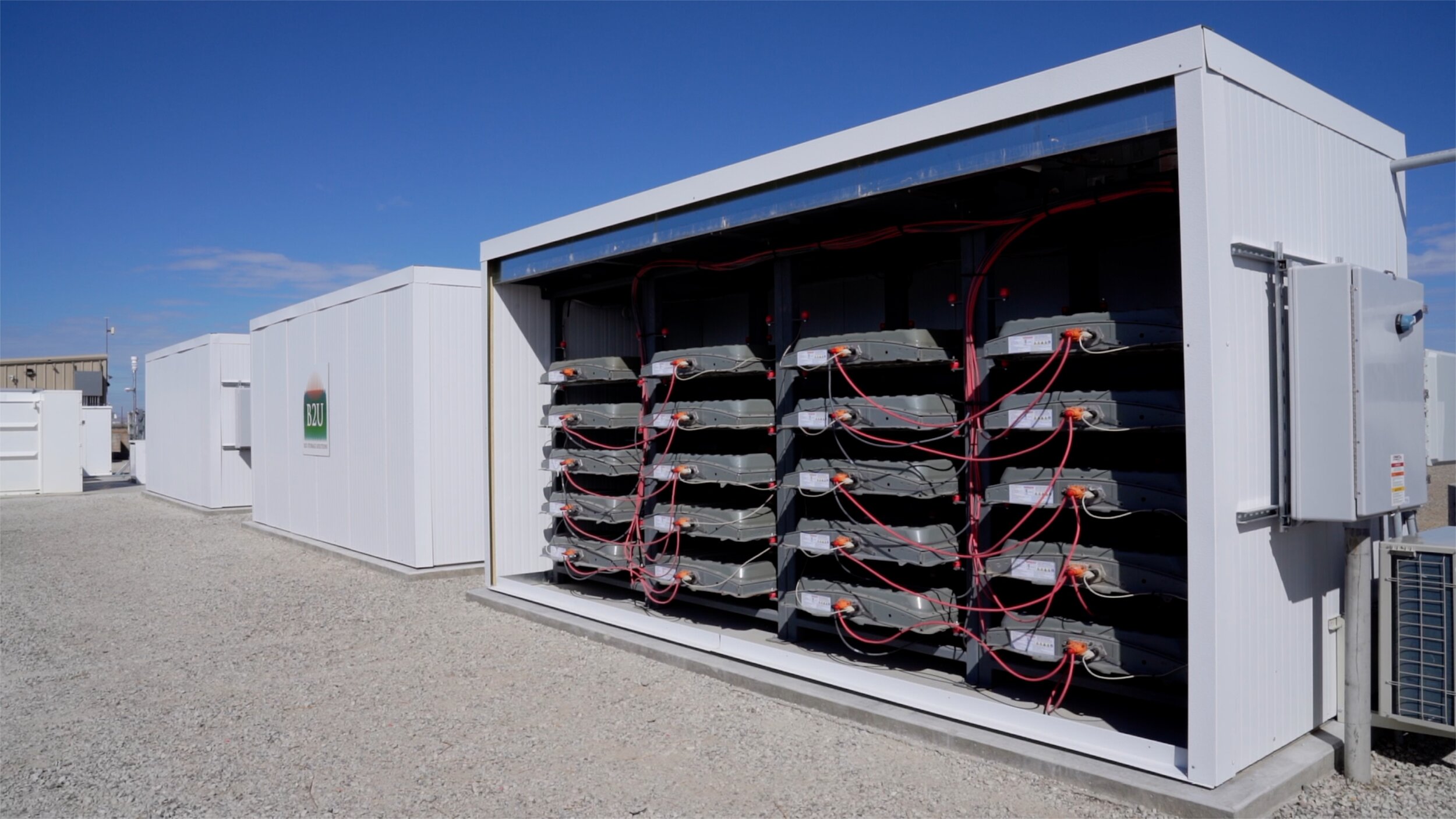This Southern California solar farm is using retired EV batteries for storing the power and then send to the grid when needed. This way the retired batteries can extend their usefulness for several…::A Southern California company is showing how repurposing EV batteries for stationary storage can extend their usefulness for several years.
That’s actually an ingenious idea I hadn’t thought about. How much cheaper are these batteries once they’ve been retired? Would this be a viable option for someone running solar at home, and wanting to store the power for later use, or is a home battery still the better option?
Yea, with a car you can’t really use them once the range gets low enough
With this, a bunch of batteries can work together for much longer. You also don’t need to worry about weight since they’re in one place
A Tesla Model 3, for example, has a battery capacity of 50 to 82 kWh. Let’s assume the lowest capacity of 50 kWh. A car battery is basically unusable long before it has lost around half its capacity. So 25 kWh. American households on average consume 10.6 MWh annually or about 29 kWh per day.
So an old Tesla battery still provides enough electricity to power an American household for nearly an entire day.
Really puts into perspective what a monumental waste of energy individual traffic, also with electric cars, is as well.
Well, sort of, it’s just that any sort of locomotion requires a lot more energy than you might think.
Yeah sure. But there’s a difference between moving a 2 ton vehicle per person or a bike.
I thought I read that this was a plan Tesla had to repurpose the car batteries into power walls for home consumers. Not sure that ever ended up happening but great to see the retired car batteries given a second life
It’s the same cells inside both batteries. The difference is that the used EV car battery will store less power per volume since it’s worn out. It is a wonderful idea. A solar farm doesn’t care as much about volume and weight as a car does. For a home it would be fine as long as you’re trying to squeeze every inch cube of your property.
A 50 KWh or more battery pack will be overkill for most homes. But those will likely be available for cheap soon so it might still be a good option. Putting a pack that weighs several hundred kilos in your basement might be difficult, though.
I don’t know that a basement would be a good location regardless. If that thing sparks up, it’ll take out half the building before the fire department shows up.
I use mine as a box spring in my bedroom
Depends on the chemistry. I’d want NMC batteries outside and LFPs can be anywhere.
Im not 100% sure how the batteries are constructed from all of the cells (and I know it depends on the model), but the re-using process can work a lot better than just pulling out the battery and popping it down. EV batteries are in the range of hundreds of volts, but the cells themselves are about 4 volts. It’s my understanding that the battery as a whole doesn’t uniformly degrade, but you might have individual cells that degrade. If 1 cell in a chain of 10 goes bad, that chain can be made off limits to the battery, so you still technically have 9/10 cells that work fine.
The way a lot of people reuse/recycle/refurb (not sure what the right terminology is in this instance) EV batteries is to test each of the cells themselves, and get rid of the duds, and keep the decent cells. Tesla, for example, all used to use 18650 cells (and I think some models still do), which is the same exact cell that’s in decent name-brand cordless power tools.
When you aren’t required to keep weight, space, and extra circuitry to a minimum, you can really design a system that squeezes every last drop of usefulness out of those cells before they need to be melted down and remade.
I’m assuming that doing full charge/discharge cycles on them daily will put more wear on them than every day driving would?
But if your buying them at scrap value and the. Still selling them as scrap after a few more years I guess it works out.
The way lithium batteries work, they wear out less if you only discharge and charge them slightly. So a battery that is charged to 60%, discharged to 40%, and repeated like that will keep most of its capacity even after years of prolonged use. On the other hand, charging a battery quickly, until it is full, or discharging it until it is nearly empty will reduce its capacity over time.
A Tesla Model 3 has a battery capacity of at least 50 kWh. Even if it has lost half of its capacity, the 20% capacity difference between 60% and 40% charge, or more realistically, the 50% difference between 75% and 25%, still represents 12.5 kWh of capacity. Suppose you had an array of 1,000 such batteries. That would represent 12.5 MWh of storage capacity, enough to power ten thousand homes (at 1.2 kW each) for an hour. Certainly nothing to sneeze at.
I’ve seen some interesting use cases for EVs themselves as a form of energy storage. Not necessarily to discharge as a voltage regulation mechanism, but as a predictive load for evening daily swing.
as a predictive load for evening daily swing
What do you mean by that?
By daily swing I mean the difference between minimum (base load) and maximum (peak) MWh demand within a 24 hour window. Typically this means low period at night and high period in morning and late afternoon/evening. The types of generation and capabilities you have on the grid basically have to accommodate this demand swing while maintaining reliability. IE you can’t just run nuclear to provide for the peak because you can’t just turn it off when it’s not needed, stuff like that, voltage has to be regulated in real time to maintain the frequency of the grid.
With increasing transportation electrification people are largely charging their cars overnight, this is increasing the overnight demand and potentially raising the minimum base load and reducing the daily swing. This means you may not need as much capabilities to fill that gap, things like ramping up hydro (renewable but environmentally destructive) or gas (GHG emitting) to handle the swing and peaks. You can imagine if demand is always kept the same it would be much easier and more reliable so this is basically a way to get closer to that. Right now there’s a lot of tools like dispatchable generation, dispatchable loads, trading over interties to neighboring jurisdictions, load-shedding, and demand response programs where if large consumers alter their usage patterns in accordance with grid conditions they receive compensation.
Being packed away in a static location has much lower energy density requirements than driving around with the battery on-board. Getting the most out of them and then reprocessing the materials seems better than just reprocessing right away once they’re no longer useful for EVs.
Exactly, it goes from being about the capacity:weight ratio to capacity:cost and as a bonus also postpones having to use powernto recycle them (and hopefully it’ll be cheaper/more efficient to do so then).
In practice they’re used more as a sort of capacitor to provide voltage regulation on the grid, basically what gas is doing for reliability. Not sure how often that wouldn’t involve a full discharge, but I know most gas in this context is running way below its capability.
It sounds like this is being used for day/night storage here as opposed to spot demand, so it may be using more of the charge range.
I wonder if these batteries have reduced peak power output, can they fulfil the kind of balancing that you are suggesting? I guess if they had enough it would be fine.
I just assume so because of their application in EVs but might also depend what kv level lines they’re stepped up for.
This is a way to get off gas as it’s used for reliability and voltage regulation. There’s a few locations running pilots with different energy storage techs like this. One of the main problems with integrating renewables is they aren’t dispatchable generation so you’re basically throwing unknowns in to the system. This is mediated through programs like demand response and load following with gas, but the goal of decommissioning gas and fossils entirely while still providing reliability is hampered because of this gap in capability. Renewables paired with storage would accommodate more less flexible renewables and SMRs, and allow for more electrification of the economy with less climate impact. More electric arc furnaces!
Good idea but good luck to the people who will try to take the fire out
Edit: I’m not saying that it’s bad, of course renewable, solar, electric is good. But knowing how horrible electric vehicle fires are to put out, I don’t see a fire of piled up batteries being an easy challenge for firefighters
Any energy storage device has risks. In this case the risk is higher, but so is the overall energy storage capability. If you store them off to the side in their own little building, there’s no real risk beyond loss of investment and environmental impacts.
Not to mention, firefighters now have tools to fight these types of fires.
Also since it’s in one place, you can build in detection and fire suppression measures.
Could be as simple as having the tools nearby (fire hydrant style), or as complex as automating the checks and suppression (cut off power, isolate the problem cells, spray em)
If these batteries are stable (ie only needs maintenance rarely) , is there a reason not to keep them in a closed, CO2 filled enclosure?
Lithium batteries can produce oxygen when at high temperature. I’m not sure if they would produce enough to be able to start burning in such conditions, but I wouldn’t rule it out (maybe someone better versed in chemistry knows). And once they start burning, the fire heats them up more, so they produce more oxygen, whch further fuels the fire.
I wouldn’t be as worried about oxygen, but more worried about properly sealing the container off as a water leak could cause the lithium in the battery’s to produce hydrogen.
But the odds off either happening are very slim.
Edit: the water has to come in contact with the lithium.
That would be cool, maybe cost to keep the CO2 levels maintained and leak proof? I’d be curious to learn more about CO2 filled enclosures. I think some rare books are kept in them?
Another alternative could be to flood the room with CO2 when an issue is detected. But I guess that’s just fire suppression again
Batteries and by extension EVs have a much lower risk of catching fire than ICE cars. Stop repeating fossil fuel industry gaslighting.
Lower risk yes, but also harder to put out yes, and also the comparison here isn’t about cars at all.
It still shouldn’t be an issue as long as you place the storage somewhere where the fire can be contained easily, then worst case the whole storage burns down but there wouldn’t be significant collateral damage.
Yeah, a huge tank of oil or natural gas or pile of coal is a total cake walk to extinguish! /s
For real.
Removed by mod
I mean, okay, but how much of anything can get hit by lightning and not be a smoldering crater without proper grounding and such?
One of my grandmothers great uncles.










